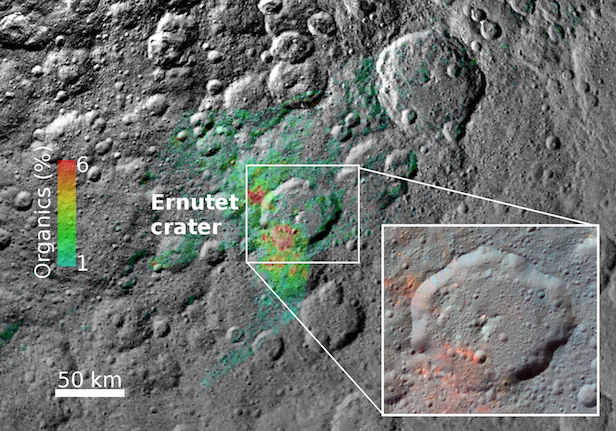Ceres’ organic material most likely made by dwarf planet
After ruling out the transportation of substances by asteroids and comets, scientists conclude that organics likely originate from Ceres

NASA’s Dawn spacecraft used its visible and near-infrared spectrometer to reveal the intriguing concentrations of organic material around the Ernutet crater. Image courtesy of NASA/JPL-Caltech/UCLA/ASI/INAF/MPS/DLR/IDA
Since NASA’s Dawn spacecraft discovered a confined region of organic-rich material on the dwarf planet Ceres, the Southwest Research Institute (SwRI) has delved into the data in an attempt to try and explain its origins. The SwRI have investigated the possibility of a comet or an asteroid transporting the organics, but the results point towards the substance being most likely native to the dwarf planet.
“The discovery of a locally high concentration of organics close to the Ernutet crater poses an interesting conundrum,” says Dr. Simone Marchi, a principal scientist at SwRI. “Was the organic material delivered to Ceres after its formation? Or was it synthesised and/or concentrated in a specific location on Ceres via internal processes? Both scenarios have shortfalls, so we may be missing a critical piece of the puzzle.”
It is commonly accepted that Ceres was formed at the dawn of the Solar System 4.5 billion years ago. By carefully analysing the organics around the Ernutet crater, it could paint a more complete picture of the origin, evolution and distribution of organic compounds throughout the Solar System. And when considering Ceres’ position within the solar neighbourhood – wedged between the inner and outer planets – combined with its fascinating composition of clays, sodium- and ammonium-carbonates, this suggests a complex chemical evolution.
“Earlier research that focused on the geology of the organic-rich region on Ceres were inconclusive about their origin,” Marchi says. “Recently, we more fully investigated the viability of organics arriving via an asteroid or comet impact.”
The two main transporters that SwRI investigated were comets and asteroids, and these models were put up against the iSALE shock physics code simulations. After modelling the impact of comet-like projectiles at relatively high velocities, the results showed the projectile would lose almost all of its organics due to shock compression. As for asteroids, the models showed that at lower incident velocities, the projectile could retain between 20 and 30 per cent of their pre-impact organic material, especially for small projectiles at oblique impact angles. The issue with this is that the localized nature of the organics on Ceres doesn’t reflect the impact delivery from small asteroid belt objects. To put more simply, Marchi says, “These findings indicate that the organics are likely to be native to Ceres.”
Keep up to date with the latest reviews in All About Space – available every month for just £4.99. Alternatively you can subscribe here for a fraction of the price!




